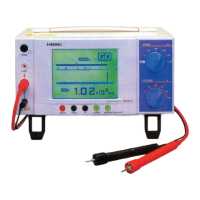39
Note 1: When the measuring time is set with the incorporated timer,
the timer has a priority over a remotely controlled switch
actuation.
When the REMOTE IN “G” and “+”
measurement will start. The measurement will automatically end
when the time set with the timer is up.
Note that when the closed “G” and “+” terminals are opened
before the time-up of the timer, the opening of the “G” and “+”
terminals has a priority over the time set with the timer.
Note 2: When the charging time is set with the incorporated timer, the
timer has a priority over a remotely controlled switch
actuation.
When the REMOTE IN “G” and “+” terminals are closed, a
charging will start. The measurement will automatically start
when the charging time set with the timer is up.
Note that when the closed “G” and “+” terminals are opened
before the time-up of the timer, the opening of the “G” and “+”
terminals has a priority over the time set with the timer.
Note 3: When both the charging time and measuring time
the incorporated timer, the timer has a priority over a remote
control.
When the REMOTE IN “G” and “+”
charging will start.
When the set charging time is up, a measurement
automatically starts. However, note that when the “G” and “+”
terminals are opened before the set measuring time is up, the
remote control has a priority over the time set with the timer.
When the set measuring time is up, a measurement
automatically ends. However, note that when the “G” and “+”
terminals are opened before the set measuring time is up, the
remote control has a priority over the time set with the timer.

